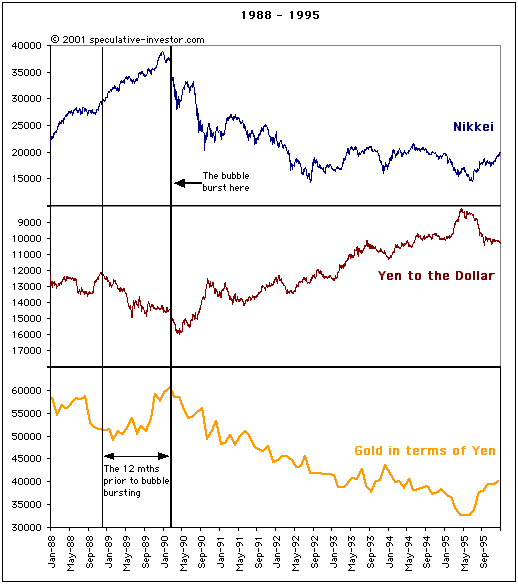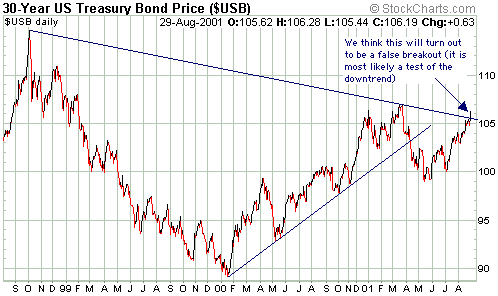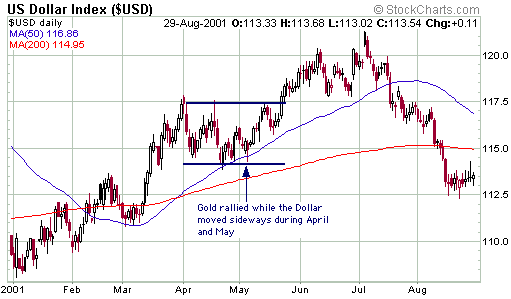|
- 29 August 2001
Inflation
- a political imperative in the US
By allowing debts to be repaid in depreciated
currency, inflation favours debtors at the expense of creditors. Also,
inflation often has the effect of boosting asset prices, thus increasing
the collateral that supports existing debts and providing the basis for
new debts. A problem inevitably arises, however, because creditors aren't
stupid - they don't like to see their real returns dwindle as a result
of loans being repaid with depreciated money. They therefore begin to adjust
interest rates higher to account for the currency's anticipated loss of
purchasing power over the period of the loan.
The US has experienced a high inflation
rate over the past few years. However, as discussed many times in the past,
the strong Dollar has suppressed the negative effects of the inflation.
By helping to keep producer and consumer prices in check, the rising trend
in the Dollar's foreign exchange value has alleviated the need for the
high market interest rates that would normally result from high inflation.
With the Dollar's foreign exchange value no longer trending skyward, a
substantial rise in long-term market interest rates is now on the cards.
American voters are up to their eyeballs
in debt, so higher market interest rates and the knock-on effects of higher
interest rates (less spending, less investment, lower growth, higher unemployment)
would cause big problems to say the least. The potential solutions? Allow
the economy to experience a severe multi-year recession to wash away the
excesses, thus guaranteeing a loss for the incumbents at the next election,
or inflate at an even faster pace to postpone the day of reckoning (hopefully,
to some time after the next election). Clearly, the political pressure
on the Fed to keep inflating will be enormous.
The big question is, if deflationary
forces take hold can the Fed keep the money supply expanding? The answer
is no, not if it sticks to its routine of simply setting a target Fed Funds
Rate. As the Japanese have shown, even taking interest rates all the way
down to zero is of no benefit if lenders stop lending and borrowers stop
borrowing. However, the Fed's power is not limited to the setting
of a Fed Funds Rate target. In fact, as the following passage from Bob
Woodward's book "Maestro" clearly shows (the passage deals with the tactics
contemplated by the Fed in the wake of the 1987 stock market crash), the
Fed's power to create money out of nothing is effectively unlimited:
"They [the Fed] had the legal
power to buy up the entire national and private debt, theoretically infusing
the system with billions, even trillions, of dollars, more than would ever
be necessary to restore liquidity and credit. Of course, the result of
that would be Latin American-style inflation.
In addition, there was an ambiguous
provision in Section 13 of the Federal Reserve Act, the lawyers told Greenspan,
that could allow the Fed, with the agreement of five out of seven members
of its board, to loan to institutions - brokerage houses and the like -
other than banks. Greenspan was prepared to go further over the line. The
Fed might loan money, but only if those institutions agreed to do what
the Fed wanted them to do. He was prepared to make deals. It wasn't legal,
but he was willing to do it, if necessary. There was that much at stake.
At that moment, his job was to do almost anything to keep the system righted,
even the previously inconceivable."
If at some future time the Fed does
make full use of the money-creating powers available to it then the power
of the Dollar (purchasing power, that is) will plummet. However, a reduction
in the Dollar's purchasing power will always be tomorrow's problem until
it gets completely out of control, at which point it will become today's
problem. Until the depreciating Dollar does become today's problem, that
is, until soaring interest rates make it today's problem, there is no reason
to expect the US monetary authorities to do anything other than inflate.
Bubble
Comparison
We can learn a lot from history, but
a mistake that is often made is to focus on the similarities between the
current time and past times while ignoring the differences. The differences
can be critical.
There are a lot of similarities between
the Japanese credit bubble of the late 1980s and the US credit bubble of
the past several years, but one huge difference (a difference that has
thrown many analysts) is that the Japanese credit and stock market bubbles
ended at roughly the same time whereas the US credit bubble continues to
go strong 18 months after the stock market peaked. The resilience of the
US credit bubble has resulted in a rather strange set of circumstances
- soaring money supply growth, a strong real estate market and moderate
increases in consumer spending in parallel with the NASDAQ experiencing
one of the worst declines in stock market history.
One characteristic of the Japanese
bubble and other previous credit bubbles that we expect to carry through
to the current US situation is a decline in the currency of the bubble
economy (relative to other major currencies and gold) during the bubble's
final stage.
Below is a chart comparing the Nikkei225
Index, the Dollar-Yen exchange rate (the scale is reversed so that a rising
line indicates a rising Yen), and the gold price in terms of the Yen from
the beginning of 1988 to the end of 1995. Note that during the final 12-15
months of the Japanese bubble the Yen fell against the Dollar and against
gold. This decline in the Yen during 1988-1989 was a trend reversal (the
Yen had been very strong from 1985 through to 1988) and signaled that the
bubble was in its final stage.

The Yen bottomed in terms of the Dollar
and gold shortly after the bubble burst and then trended higher for the
next 5 years. Whether or not the Dollar follows this pattern and begins
trending higher after the US bubble bursts will be determined by the response
of the Fed.
The US
Stock Market
Stocks and Bonds
In the latest Weekly Market Update
we said "...if bonds spike up into the 106-107 range (just below the
March peak) over the coming 1-2 weeks in parallel with another pullback
in the stock market, they would present a spectacularly-good selling
opportunity." September bonds closed at 106-6/32 on Wednesday, so they've
moved into the selling range. Bonds may see some additional near-term upside
if stocks continue to decline, but they are now within shouting distance
of the March peak and we do not expect them to exceed this prior peak.
The bond market peaks in January and
March coincided, to the day, with bottoms in the equity market and the
current pattern is unfolding in exactly the same way. During the 4 weeks
following the March-22 peak in bonds that corresponded with the intra-day
low in the S&P500, bond futures plunged 6 points (a very large move
for this market). We expect something similar to occur this time around
and, although a bit more upside is possible over the next few days, we
are now short-term bearish on bonds (we have been long-term bearish since
early-January).
The approaching peak in bonds is also
a sign of an approaching bottom in stocks.

Current Market Situation
From the August-27 WMU: "The ideal
pattern for the coming week would be for the market to initially move higher
and then drop late in the week to test the lows reached on August-21/22."
And "...we would actually be less enthusiastic about the prospects for
the coming 2 months if the market does not pullback but instead
ramps higher into the Labor Day weekend."
We didn't get any early-week strength,
but have got the drop back to the August-21/22 lows (slightly lower for
the S&P500 and slightly higher for the NASDAQ100). The ideal situation
(from a bullish perspective) would see the market spike lower over the
coming one or two trading sessions in parallel with a final surge in bonds.
That would give us the perfect set-up for our anticipated September-October
rally.
It is always emotionally difficult
to move in one direction while the herd is stampeding in the opposite direction,
but that is what we are going to do because the market's panic attack is
creating an exceptional opportunity. We are mindful of the fact that the
trend is down and that an emotional washout is possible, so this is certainly
no time to be buying on margin. However, we think that those traders who
buy on weakness over the next 1-5 trading sessions will be handsomely rewarded.
We purchased one position in QQQ shares last week at around current levels
and will add a second position if the market spikes lower today (with a
sell-stop set just below the early-April low).
Gold and
the Dollar
Current Market Situation
We expect the counter-trend rebound
in the Dollar that commenced last week to continue for at least one more
week. A reasonable objective for this rebound is a return, by the Dollar
Index, to its 200-day moving-average (currently situated at around 115,
versus yesterday's close of 113.54). Likewise, it would be normal for the
euro to pullback to its own 200-day moving-average at around 0.89.
We expect the pullback/consolidation
in the gold price that began last week to continue into next week in parallel
with the Dollar's rebound. Gold appears to be setting itself up for a rally
and, once ready to go, will probably just need an absence of Dollar strength
rather than serious Dollar weakness in order to move higher. Recall that
during April and May the gold price rallied as the Dollar traded sideways
(see Dollar Index chart below) and reversed lower on the same day (May-22)
that the Dollar broke upwards out of its flat consolidation.

During April and May the gold and stock
markets rallied while bonds tanked. This occurred because the financial
markets came to embrace the belief that the deflation-fighters at the Fed
were going to be victorious. We can envisage a similar outcome for the
next 2 months.
Changes
to the TSI Portfolio
No changes.

|

